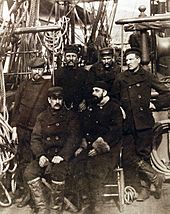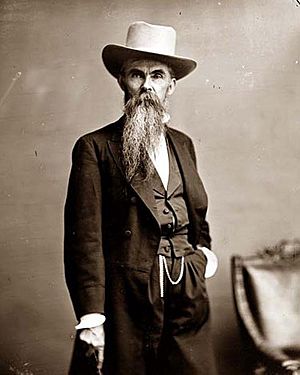Chester A. Arthur facts for kids
Quick facts for kids
Chester Alan Arthur
|
|
|---|---|
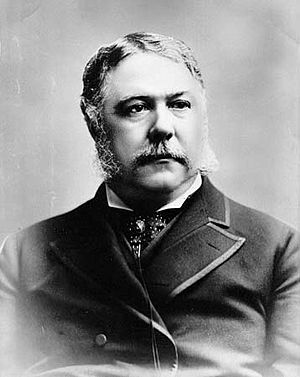 |
|
| 21st President of the United States | |
| In office September 19, 1881 – March 3, 1885 |
|
| Vice President | None |
| Preceded by | James A. Garfield |
| Succeeded by | Grover Cleveland |
| 20th Vice President of the United States | |
| In office March 4, 1881 – September 19, 1881 |
|
| President | James A. Garfield |
| Preceded by | William A. Wheeler |
| Succeeded by | Thomas A. Hendricks |
| Personal details | |
| Born | October 5, 1829 Fairfield, Vermont |
| Died | November 18, 1886 (aged 57) New York City, New York |
| Nationality | American |
| Political party | Republican |
| Spouse | Ellen Lewis Herndon Arthur |
Chester Alan Arthur (October 5, 1829 – November 18, 1886) was an American lawyer and politician. He became the 21st President of the United States in 1881. He served until 1885.
Before becoming president, he was the 20th vice president. He took over as president after President James A. Garfield passed away in September 1881. Garfield had been shot by an assassin two months earlier.
Contents
Who Was Chester A. Arthur?

Chester Alan Arthur was born in 1829 in Fairfield, Vermont. He grew up in upstate New York. He was the fifth of nine children in his family. His father, William Arthur, was from Ireland. His mother, Malvina Stone, met William when he was a teacher.
The Arthur family moved often because of William's job as a minister. They finally settled near Schenectady, New York. Chester had seven brothers and sisters who lived to be adults. One of his sisters, Mary, later served as the official White House hostess during his presidency.
Arthur's Path to Politics
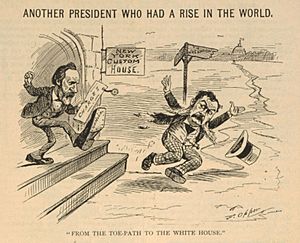
Chester Arthur went to Union College in New York. He studied law and became a teacher. In 1854, he became a lawyer in New York City. He joined a law firm that supported ending slavery.
During the American Civil War, he worked for the New York Militia. After the war, he became more involved in politics. He joined the Republican Party in New York. President Ulysses S. Grant appointed him to a big job in 1871. He became the Collector of the Port of New York. This meant he was in charge of collecting taxes on goods coming into New York.
In 1878, President Rutherford B. Hayes removed Arthur from this job. This was part of a plan to change how government jobs were given out.
Becoming Vice President
In 1880, James A. Garfield was chosen to run for president by the Republican Party. Arthur was chosen to be his vice president. This was done to balance the ticket. They won the election.
Just four months after they took office, President Garfield was shot. He passed away 11 weeks later. This meant that Chester Arthur became president.
Chester A. Arthur's Presidency

When Arthur became president, many people were unsure about him. They thought he might not be a good leader. But he surprised many by supporting important changes.
He helped to rebuild the "New Navy". This made the U.S. Navy stronger. However, he was criticized for not fixing a problem with the government having too much money.
Arthur also dealt with immigration issues. He vetoed an early version of the Chinese Exclusion Act. This law would have stopped Chinese immigrants from coming to the U.S. for 20 years. He said it broke a treaty. But he signed a second version that had a 10-year ban.
Arthur had poor health during his presidency. He did not try very hard to be nominated for president again in 1884. He left office at the end of his term. Today, historians often remember him as one of the less well-known presidents.
Civil Service Reform
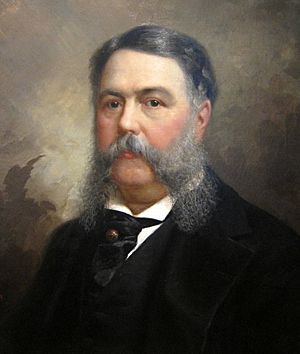
After President Garfield was shot, people wanted big changes in how government jobs were given. Before, jobs were often given to friends or supporters, not always the best person for the job. This was called the "spoils system."
In 1881, Arthur asked Congress to pass a law to fix this. On January 16, 1883, he signed the Pendleton Civil Service Reform Act into law. This law made sure that many government jobs would be given based on merit. This meant people had to pass an exam to get the job.

Arthur quickly set up the United States Civil Service Commission. This group helped make the new system work. By 1884, many jobs were given based on merit. Arthur was happy with the new system. He said it worked very well.
Government Money and Tariffs
After the Civil War, the government collected more money than it spent. By 1882, it had a lot of extra money. This was called a "surplus."
People had different ideas about what to do with this money. Some wanted to lower tariffs. Tariffs are taxes on goods imported from other countries. Lowering them would make imported goods cheaper. Others wanted to keep tariffs high to protect American jobs. They wanted the government to spend more on projects like roads and bridges.
Arthur agreed with his party. He wanted to get rid of some taxes and simplify the tariff system. A committee suggested lowering tariffs. But Congress only made small changes. The new law, the Tariff of 1883, did not really fix the surplus problem.
Congress also tried to spend more money. They passed a bill to spend $19 million on rivers and harbors. Arthur thought this was too much money. He also felt the projects only helped small areas, not the whole country. He vetoed the bill. But Congress voted to pass it anyway.
Foreign Relations and Immigration
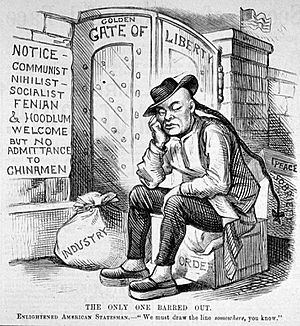
Arthur wanted to improve trade with countries in North and South America. A trade agreement with Mexico was signed in 1882.
Congress also spent a lot of time on immigration laws. In 1882, Arthur signed the Immigration Act of 1882. This law put a small tax on immigrants. It also stopped people with mental illness, criminals, or those who might need public help from entering the U.S.
A big debate was about Chinese immigrants. In 1868, a treaty allowed Chinese people to come to the U.S. freely. But as the economy got worse, some blamed Chinese immigrants for taking jobs. Congress tried to stop Chinese immigration. President Hayes had vetoed an earlier attempt.
Arthur signed the Chinese Exclusion Act into law on May 6, 1882. This law tried to stop most Chinese immigration for ten years. It made exceptions for diplomats, teachers, students, and merchants.
Arthur believed the United States needed a stronger Navy. In 1881, he asked for more support for the Navy. His Secretary of the Navy, William E. Chandler, worked hard to modernize it.
Chandler created a board to plan for a new Navy. They wanted a Navy that could protect America far from its coasts. Based on their ideas, Congress approved money to build new steel ships. These ships were called the ABCD Ships (Atlanta, Boston, Chicago, and Dolphin). They were the start of the modern U.S. Navy.
Greely Polar Expedition Rescue (1884)
In 1881, a U.S. Army science team led by Adolphus Greely was exploring the Arctic. They were left stranded at Fort Conger. Two attempts to resupply them failed. The ships either got stuck in ice or were crushed.
By 1883, Greely and his team were running out of food. They moved to a new camp, Camp Clay, hoping to find supplies. But they couldn't get enough food, and people started to starve.
President Arthur and his Navy Secretary, William Chandler, worked hard to save them. Chandler was determined to succeed. He sent Commander Winfield Schley to lead a new rescue mission. Chandler even bought a special ship, the USS Bear, for the rescue.
On July 17, 1884, Schley found the Greely party. Only seven men had survived. One of them passed away soon after being rescued. Arthur praised everyone who helped with the successful rescue.
Civil Rights and Native American Policy
After the Civil War, many Southern states made it hard for Black Americans to vote. Arthur tried to support new political groups in the South. These groups, like the Readjusters in Virginia, wanted more education funding for all children. They also wanted to end unfair voting taxes.
Arthur supported these groups. Some Black Republicans felt unsure about this. But others, like Frederick Douglass, supported it. They believed these new groups had better ideas about race than the old Southern Democrats. However, Arthur's plan only really worked in Virginia.
In 1882, Arthur signed the Edmunds Act. This law made polygamy (being married to more than one person) a federal crime. It also stopped polygamists from holding public office or voting.
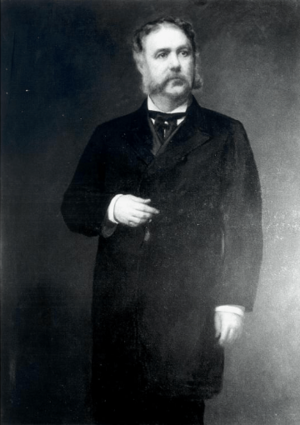
Arthur also dealt with issues facing Native American tribes. He wanted Congress to give more money for Native American education. He also supported a new system where Native Americans would own land individually, not as tribes. This idea was meant to help them, but it often led to Native American land being sold cheaply to others.
During his time, settlers continued to move onto Native American lands. Arthur initially tried to stop this. But later, he opened up the Crow Creek Indian Reservation to settlers. His successor, Grover Cleveland, later reversed this decision.
Arthur's Family Life
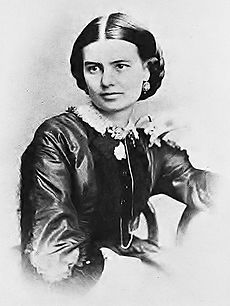
In 1859, Chester Arthur married Ellen Herndon. She was the daughter of a naval officer. They had three children together:
- William Lewis Arthur (1860–1863), who passed away as a young child.
- Chester Alan Arthur II (1864–1937).
- Ellen Hansbrough Herndon "Nell" Arthur Pinkerton (1871–1915).
Images for kids
-
Arthur's home where he spent most of his adulthood years in Manhattan, New York City
-
The New York Custom House (formerly the Merchants' Exchange building at 55 Wall Street) was Arthur's office for seven years.
-
Arthur taking the oath of office as administered by Judge John R. Brady at Arthur's home in New York City, September 20, 1881
-
Chester A. Arthur statue at Madison Square in New York City, Bissell 1898
See also
 In Spanish: Chester A. Arthur para niños
In Spanish: Chester A. Arthur para niños




